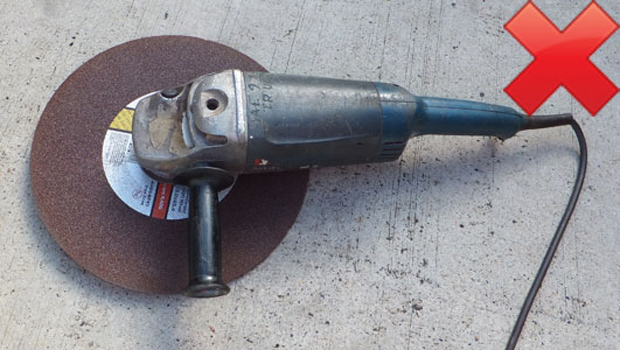
March 14, 2016
Worksafe Queensland has issued a safety alert after a Queensland worker was killed last month while operating a 9 inch (230mm) angle grinder.
The worker was killed when part of a broken disc struck his chest. The high impact of the projectile caused fatal internal injuries.
In a separate incident, a worker’s wrist was cut when an angle grinder’s disc jammed and the device kicked back.
“One major contributing factor is the use of cutting discs that are too large for the angle grinder,” Worksafe Queensland said.
“In some cases the guards have been removed and the grinder fitted with a 14 inch (356mm) cut-off disc.”
Cutting discs are usually designed for a maximum outside edge speed of 250 kmph (70 m/s). Larger angle grinders are manufactured with lower revolutions per minute than smaller angle grinders, so that the edge speed of the disc always remains around 70 metres/second.
But fitting a 14 inch (356mm) cut-off disc to a 9 inch (230mm) angle grinder will increase the edge speed to at least 120 m/s (430 kmph), which is excessive.
“Guards should be provided and used on all power tools where there is a risk of the disc ejecting, disintegrating or cutting the worker,” Worksafe said.
If the guard has been removed:
- there is nothing to stop the broken pieces hitting the user
- the user’s hand will be closer to the unguarded moving blade
- there is also a greater risk of the blade being damaged when the angle grinder is put down and the weight of the grinder is resting directly on the disc
“Another factor that increases the risk of disc failure is when the central disc hole size is too large for the spindle flange on the angle grinder,” Worksafe warns.
“As the disc diameter increases so will the hole size.
“For example, the hole size of a 14 inch (356mm) cut-off wheel is typically 25.4 mm compared to 22.3 mm on a 9 inch (230mm) cutting disc. If the disc hole is too big for the spindle flange, the disc may be off centre, become unbalanced and vibrate excessively, and this will rapidly lead to it shattering.”
Always:
- Use the angle grinder with the correct guard supplied by the manufacturer
- Fit the right sized disc that has a hole matching the spindle flange
- Use the tightening tool supplied by the grinder manufacturer to tighten the disc. The use of another
device (i.e. punch and hammer) can damage the disc and grinder
- Hold the angle grinder with both hands ensuring the side handle is inserted on the side of the unit that gives the best grip for the work activity
- Use a grinding disc for grinding. Grinding with a cutting disc damages the disc and increases the likelihood of the disc breaking during use
- Ensure the maximum RPM disc speed marked on the disc is higher than the maximum speed of the angle grinder
- Ensure damaged discs are thrown out and not re-used
- Allow the grinder to run to speed before cutting or grinding
Note: 9 inch (230mm) angle grinders have been banned on some work sites due to the increased risk of injury. The increased power and size of the unit will cause more severe kickback and gyroscopic effects (ie makes the grinder difficult to manoeuvre). A risk assessment to identify alternative methods and tools should be carried out prior to selecting a 9 inch (230mm) angle grinder.
























